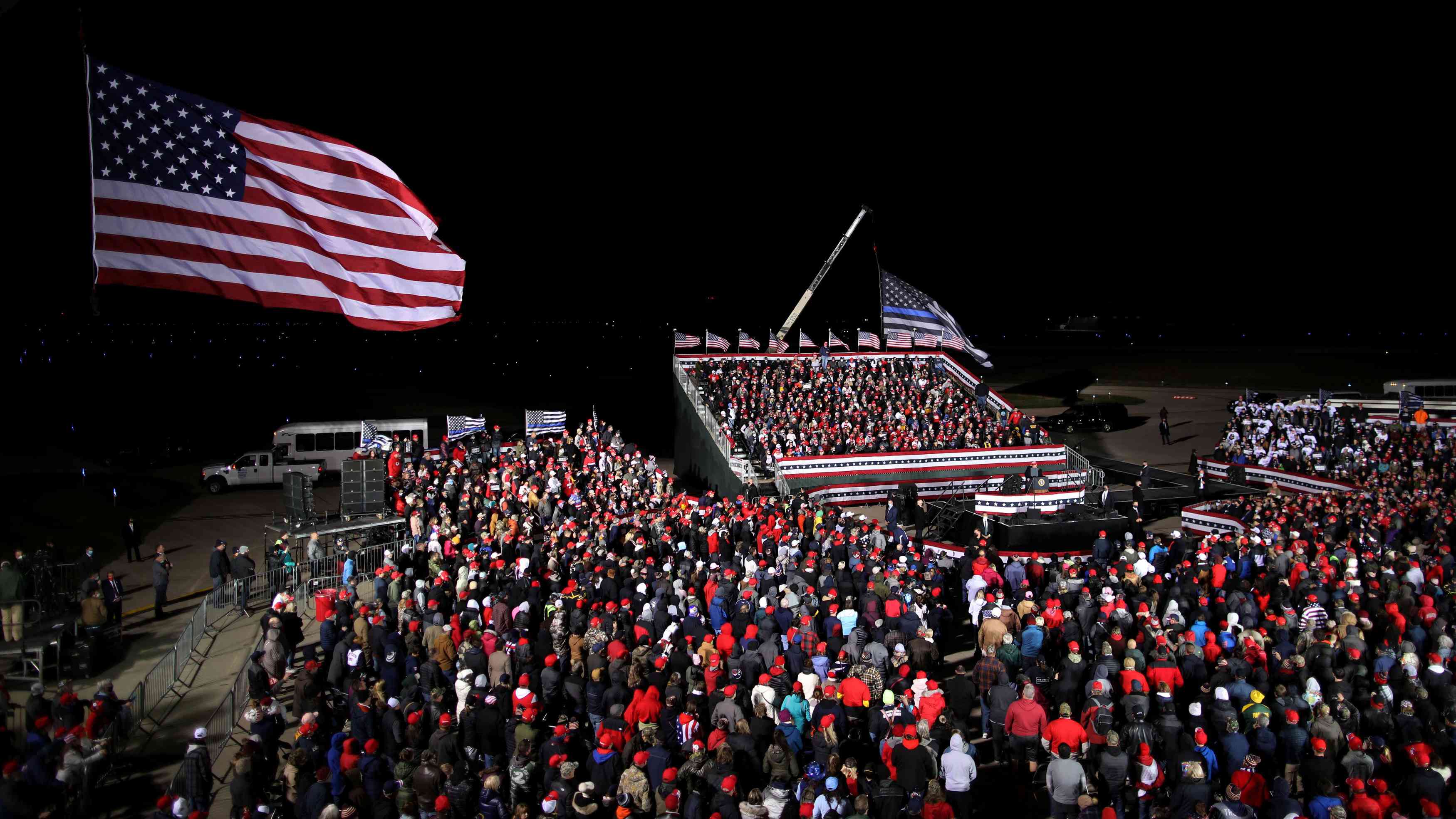
Supporters of U.S. President Donald Trump sell Trump flags and merchandise from a roadside carnival booth in Hubbard, Ohio, U.S., October 15, 2020. /Reuters
Supporters of U.S. President Donald Trump sell Trump flags and merchandise from a roadside carnival booth in Hubbard, Ohio, U.S., October 15, 2020. /Reuters
Editor's note: Hannan Hussain is a foreign affairs commentator and an author. He is a Fulbright recipient at the University of Maryland USA (2020-2022), and a former assistant researcher at the Islamabad Policy Research Institute (IPRI). The article reflects the author's opinions, and not necessarily the views of CGTN.
As anticipation heats up for the final presidential debate on October 22, U.S. President Donald Trump is determined to extend his campaign momentum to a broad range of American states. Consecutive rallies in Michigan and Wisconsin marked his campaign's scramble across the Midwest on Saturday, and scheduled visits to Arizona and North Carolina will form a pattern around some of Biden's latest stopovers. But the president faces an emerging set of challenges in courting America's unprecedented pool of early voters, some 28 million of which have already cast a ballot.
His immediate challenge stems from suburban voters, a pivotal cluster that is less taken by Trump's sweeping generalizations about their livelihoods, economic mobility and party preferences. In fact, factors such as a historic gender gap appear to be adding to Trump's losses among voters in swing state polls. Unlike Biden, Trump's urgency to court American suburbs is also marked by historical baggage. For instance, a contributing factor to his 2016 victory over former Secretary of State Hillary Clinton was a narrow edge in suburban localities. In order to transform that margin into a decisive advantage this year, it is important to identify the suburban electorate's increasingly moderate pivot across many ultra-conservative counties.
Instead of taking note, Trump chooses to tout racial tensions as a law-and-order guarantee, ensuring that his campaign strategy remains averse to local-level adaptation. The move also puts the spotlight on re-election fears within his own campaign. In the closing weeks of the election race, Trump's campaign appears convinced that a loss of support among suburban women could eclipse his re-election bid for good.
Interestingly, the president's push to galvanize last-minute support is also powered by the religious right. On October 18, he reveled in his evangelical support base in Nevada, entertaining divine prophecies that suggest a November victory is inevitable. "At 4:30, the Lord said to me, 'I am going to give your president a second win … you will be the president again," announced Denise Goulet, one of the pastors at the International Church of Las Vegas. Two separate polls from Pew and Washington Post/ABC put Trump's lead with White Christians 78 points higher than Biden, despite a slip in support. But the Trump campaign's limitations lie in extending similar consistency to the broader bulk of young voters and older segments in America, who place a high value on virus containment and the state of the economy.

U.S. President Donald Trump holds a campaign rally at Southern Wisconsin Regional Airport in Janesville, Wisconsin, U.S., October 17, 2020. /Reuters
U.S. President Donald Trump holds a campaign rally at Southern Wisconsin Regional Airport in Janesville, Wisconsin, U.S., October 17, 2020. /Reuters
In Wisconsin for instance, Trump's unkept promise of the greatest economy in history enjoys an embarrassing contrast to his pandemic victory pledge, fictitious manufacturing job gains, and limited notice of four-digit COVID-19 infections across the state. In other battleground states, Trump can be seen marketing his campaign events as 'protests' to easily circumvent state guidelines on public gatherings. Taken together, there is ample reason to suggest Trump's act of defiance may lose steam this week.
First, a surge in COVID-19 cases is precisely why a record number of Americans have opted for early voting. By repeatedly focusing campaign rallies on downplaying the virus, Trump gambles on campaign support without owning up to the masses' top voting concerns. The virus has already transformed election discourse across pivotal conservative counties, and could easily place limitations on the mobilization of elderly voters. Moreover, in Trump's must-win state of Florida, nearly two-thirds of registered Latino voters now appear confident in Biden's ability to address the health impact of COVID-19, and generate sound economic policy decisions. Trump's promise of a prosperous future is merely an extension of America's past.
Despite a significant chunk of early voters identifying as Democratic, there is no guarantee that this trend will persist. Given how early voter trends operate in the United States, there is limited knowledge of the overall tally in a pandemic. This effectively renders any majority or minority estimate of the overall early vote as speculative.
Compounding things further is the metric of "party affiliation". A voter's registration as a Democrat or Republican does not necessarily dictate his candidate of preference. This fluidity of choice is a reason why Trump's potential resurgence must never be underestimated.
However, unlike party affiliation, deep-seated voter concerns are less vulnerable to overnight change, and more resistant to aggressive rhetoric. Their weight reflects in Biden's sustained advantage in national polls, as well as his marginal edge in battleground surveys. In both cases, his lead is in line with current voter concerns, while Trump continues to perform to the contrary.
"Donald Trump can still win this race," warned the Biden campaign in a recently circulated memo.
It is clear why the president can't extend a similar cause for voter introspection. He has billed his success as a given.
(If you want to contribute and have specific expertise, please contact us at opinions@cgtn.com.)